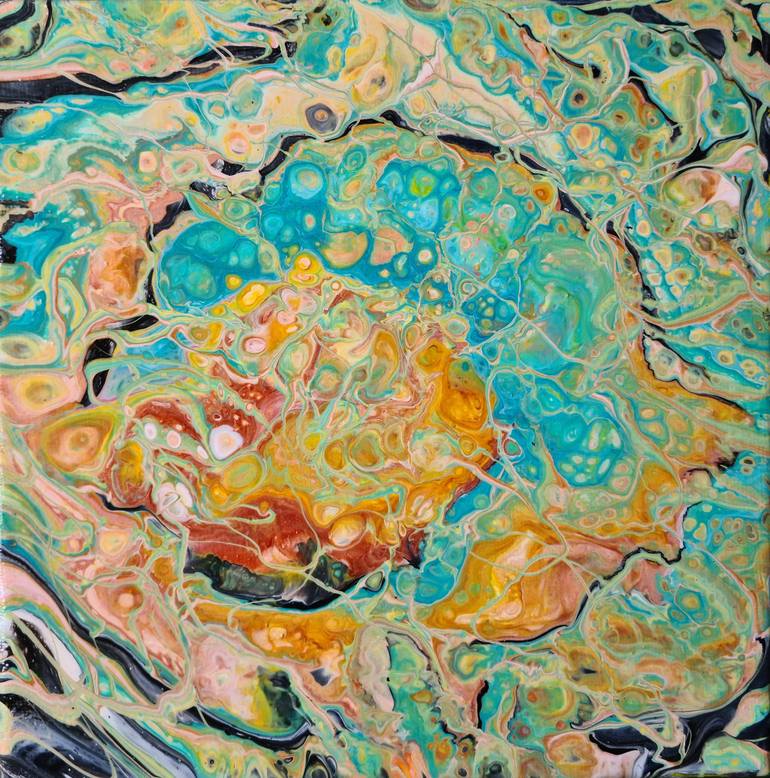







VIEW IN MY ROOM
Turquoise Mandala Painting
Australia
Painting, Acrylic on Canvas
Size: 7.9 W x 7.9 H x 0.6 D in
Ships in a Box
Shipping included
14-day satisfaction guarantee
About The Artwork
The Tibetan word "mandala" literally means that which surrounds the centre. "Center" means "value" and is surrounded by a symbol representing the meaning. Usually, the mandala is a round symbol with deep meaning. However, not all mandalas are round. The concept came to the West thanks to Carl Jung: he, studying the subconscious, came close to the study of mandalas. Drawing them on his own and offering them to his patients, he noticed that the drawings do not repeat from time to time, and each time, they change, reflecting the internal state at the moment! This seemed interesting to him and then to many of his colleagues. Mandalas began to be used in psychotherapy. An experienced specialist, asking you to draw a mandala, will then interpret the meaning of the drawings and symbols that make up it and draw conclusions about your state of mind—for example, line thickness. If you paint the outer circle with a bold line, you seem to want to isolate yourself from the outside world, from people's aggressiveness. If the outer line is thin and discontinuous, and the space inside the drawing has a lot of "air" (not filled with drawings), you are a sociable person, easily making contact. Are there many winding, intricate lines inside? Most likely, you are a woman and an emotional, sensual woman. If you are a man, you may be under stress and do not understand what to do next. If a woman draws a mandala and places a flower in its centre, she is 100% feminine. In any case, a flower in a female mandala is good. Are the triangles, symbols of movement, pointing in opposite directions? You are at a crossroads, and so far, you cannot set a direction for yourself.
Details & Dimensions
Painting:Acrylic on Canvas
Original:One-of-a-kind Artwork
Size:7.9 W x 7.9 H x 0.6 D in
Frame:Not Framed
Ready to Hang:Not applicable
Packaging:Ships in a Box
Shipping & Returns
Delivery Time:Typically 5-7 business days for domestic shipments, 10-14 business days for international shipments.
Handling:Ships in a box. Artists are responsible for packaging and adhering to Saatchi Art’s packaging guidelines.
Ships From:Australia.
Have additional questions?
Please visit our help section or contact us.
Australia
I am a self-taught artist with no special education. I enjoy working with Acrylic Pour Art and Epoxy Resin styles. Creativity helps me reach my potential, go beyond the daily control of emotions, and express them in colour. For example, by observing what pattern the paint leaves, I direct the flow of it. I would call this state: "Dancing with colours." I prefer bright colours that can be mixed. I see overflows and transitions from one colour to another. They remind me of the flowering of nature, the sky, the ocean, sunsets and sunrises, cut stones and the drawing of the earth from the aeroplane window. It fills everything with energy and creates a good mood. I am inspired by bright colours and a variety of possibilities, the unpredictability of the result of each painting, originality and uniqueness. I hope you like my pictures.
Thousands Of Five-Star Reviews
We deliver world-class customer service to all of our art buyers.
Global Selection
Explore an unparalleled artwork selection by artists from around the world.
Satisfaction Guaranteed
Our 14-day satisfaction guarantee allows you to buy with confidence.
Support An Artist With Every Purchase
We pay our artists more on every sale than other galleries.
Need More Help?